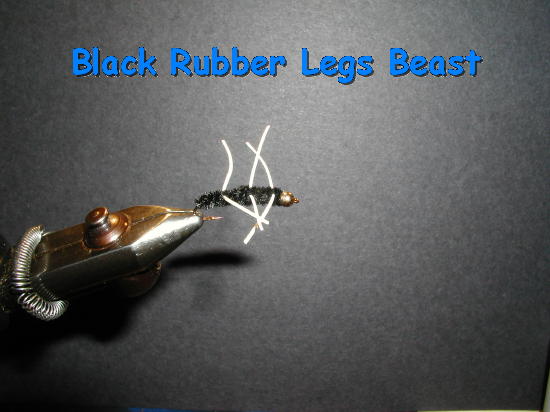
MATERIALS
- Hook: Standard streamer,
such as Tiemco 5262 or Mustad 9672, in sizes 2-8
- Thread: Black flat waxed 6/0
- Weight: .015 lead or
substitute
- Bead: Gold, sized
to fit hook (optional)
- Body: Black medium
chenille
- Legs: White round rubber
leg material
|
Black Rubber Legs
Beast
This pattern is as old as
dirt. Yet it still catches fish at certain times and in certain places. I
guess that’s why it’s old as dirt. And simple…Lord, it’s simple to
tie. I’ve had success on this beast when, in early season, the water is
murky. It does, I suppose due to the contrast between black and white,
present itself as a visible morsel to hungry trout. It can be tied with or
without a bead at the head. Although the pattern featured here calls
for black chenille, don’t be afraid to experiment with olive and other
colors. Weight is added to keep the fly down; more or less weight may be
called for by stream conditions.
|
INSTRUCTIONS
-
Place
bead on hook, if bead is to be used. Wrap 6-10 turns of lead or
substitute at the front of the hook, leaving at least 1/8” to 3/8”
(depending on hook size) of room in front of the lead.
-
Cover
hook and lead with thread.
-
Tie
in chenille at the bend of the hook, just above the back of the barb.
-
Using
hackle pliers, rap chenille forward a few wraps and let it hang down
with hackle pliers.
-
Cut
two strands of rubber leg material about 2 inches long. Take one of them
and bring one end under the hook and pull both ends upward, stretching
the material slightly. Now tie an over hand knot and slide the knot down
to the hook shank, with the material sticking out both sides of the
hook.
-
Wrap
thread around the overhand knot, manipulating the legs so that they
stand straight out (90 degrees) from the hook shank. Move the thread
forward to behind the eye.
-
Wrap
the chenille behind and in front of the legs, and advance it forward to
about the 1/3 point on the shank, and let it hang with hackle pliers
attached.
-
Repeat
steps 5 and 6 with the second piece of rubber leg material.
-
Repeat
step 7, bringing the chenille to a point about 1/8 inch behind the eye
if no bead used, or 1/8 inch behind the bead if one is used.
-
Tie
off the chenille and apply superglue to the tie-off area.
-
Form
a nice, small head (if not using a bead), and whip finish, and….
|

